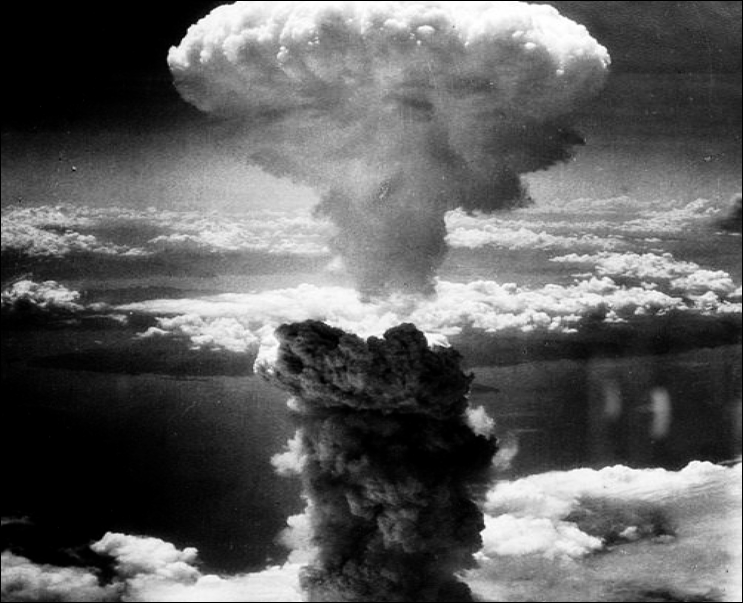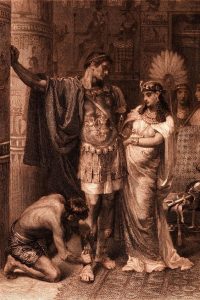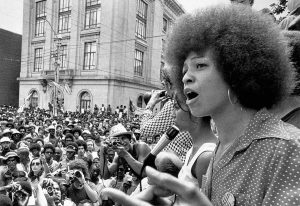Winner of the Spring 2017 StMU History Media Awards for
Best Article in the Category of “World History”
“We knew the world would not be the same. A few people laughed, a few people cried, most people were silent. I remembered the line from the Hindu scripture the Bhagavad Gita. Vishnu is trying to persuade the prince that he should do his duty and to impress him takes on his multiarmed form and says, ‘Now, I am become Death, the destroyer of worlds.’ I suppose we all thought that one way or another.”1
- J. Robert Oppenheimer, The Decision to Drop the Bomb

Throughout the history of human warfare, conflict has pushed humans to innovate–to build ever larger and deadlier weapons, each more lethal than the last. However, it was not until World War II and the invention of the atomic bomb that humanity has been able to kill on such a massive and efficient scale. Case in point, in the final days of World War II, the United States carried out one of the most chilling instances of mass murder in the history of humanity: the bombing of the Japanese cities of Hiroshima and Nagasaki. These attacks ultimately killed an estimated 294,000 people, the majority of whom were noncombatants.2 In comparison, the Japanese attack on Pearl Harbor killed just 2,408 American citizens, although this is largely due to the focused Japanese attack on military targets, namely the Pacific fleet and U.S. airfields.3 To give a more modern frame of comparison, the terrorist attacks against the World Trade Center and Pentagon, considered to be by far the worst terrorist attacks against the United States, claimed the lives of 2,974 American citizens.4
In the spring of 1945, World War II was entering its final stages. The Allies had already achieved victory in Europe with Germany’s surrender on May 7th, but the conflict on the Pacific front was still going strong. In the years leading up to the two World Wars, Japan’s victories against two larger countries–China in the Sino-Japanese War (1894–1895) and Russia in the Russo-Japanese War (1904–1905)–combined with other factors, forged a strong sense of Japanese nationalism, militarism, and cultural superiority. This fervent nationalism, integrated with the Japanese warrior ethic known as bushido, made the prospect of a Japanese surrender unlikely, even as the Allies began to position for an invasion of the Japanese mainland.5

Concurrently, since as early as 1942, President Franklin Delano Roosevelt had been secretly sponsoring and funding The Manhattan Project, the code name used for the $2 billion U.S. effort to develop a nuclear weapon before the Germans. A team of top physicists led by Dr. Julius Robert Oppenheimer were assigned to this project, a task so secret that not even individuals as important as then Vice President Harry S. Truman was aware of it. Shortly after Roosevelt’s untimely death and Truman’s subsequent inauguration to the presidency in April 1945, he was informed that the Manhattan Project was approaching success–that a nuclear weapon would be feasible in just four short months.6
Faced with the prospect of a costly and deadly invasion of Japan, Truman and his advisors were faced with a difficult choice: utilize this new atomic weapon or try to defeat Japan through conventional means. In late July, the United States issued the Postdam Declaration, a statement which gave Japan the choice between unconditional surrender or total annihilation. When this declaration went ignored, President Truman authorized the use of the atomic bomb.7

On the morning of August 6, 1945, Colonel Paul Tibbets piloted the Enola Gay over the city of Hiroshima, where his crew dropped an atomic bomb code-named “Little Boy.” Upwards of 70,000 people died instantly in the blast. Additionally, 48,000 buildings were destroyed and another 22,000 were damaged, leaving only 6,000 buildings untouched. Three days later, on August 9th, a second bomb was dropped onto Nagasaki, killing another 36,000 people. In total, an estimated 295,000 were killed in the blasts or from complications from the resulting nuclear fallout.8
Emperor Hirohito ordered the surrender of Japan on August 10, 1945. On August 15th, radios across Japan broadcasted Hirohito’s words as he read the declaration of surrender to the Japanese people, thus ending World War II. The bombs’ effectiveness in forcing the Japanese to surrender is still subject of popular debate among historians to this day, given that the Russian invasion of Japan-controlled Manchuria occurred at the same time of Nagasaki, both of which likely impacted Japan’s will to continue fighting.9 Even so, while the political and military effects of these blasts may be debated, none can contest their tragedy and devastation.

- Jason Pontin, “Oppenheimer’s Ghost,” MIT Technology Review, October 15, 2007. https://www.technologyreview.com/s/408835/oppenheimers-ghost/. ↵
- Dennis W. Cheek, “Hiroshima and Nagasaki,” in Encyclopedia of Science, Technology, and Ethics, edited by Carl Mitcham, Vol. 2, Detroit: Macmillan Reference USA, 2005. Gale Virtual Reference Library (accessed February 6, 2017), 923. ↵
- Sonia Benson, Daniel E. Brannen, Jr., and Rebecca Valentine, “Pearl Harbor Attack,” in UXL Encyclopedia of U.S. History, Vol. 6, Detroit: UXL, 2009. Gale Virtual Reference Library (accessed February 6, 2017), 1208. ↵
- Stefan M. Brooks, “September 11 Attacks,” in The Encyclopedia of Middle East Wars: The United States in the Persian Gulf, Afghanistan, and Iraq Conflicts, edited by Spencer C. Tucker, Vol. 3, Santa Barbara, CA: ABC-CLIO, 2010. Gale Virtual Reference Library (accessed February 6, 2017), 1096. ↵
- “The United States Drops the Atomic Bomb on Hiroshima and Nagasaki,” in Global Events: Milestone Events Throughout History, edited by Jennifer Stock, Vol. 2, Asia and Oceania, Farmington Hills, MI: Gale, 2014. Gale Virtual Reference Library (accessed February 5, 2017), 361. ↵
- “An Overview of the Atomic Bombings of Hiroshima and Nagasaki,” in The Atomic Bombings of Hiroshima and Nagasaki, edited by Sylvia Engdahl, Perspectives on Modern World History, Detroit: Greenhaven Press, 2011. Gale Virtual Reference Library (accessed February 6, 2017), 13-14. ↵
- “An Overview of the Atomic Bombings of Hiroshima and Nagasaki,” in The Atomic Bombings of Hiroshima and Nagasaki, edited by Sylvia Engdahl, Perspectives on Modern World History, Detroit: Greenhaven Press, 2011. Gale Virtual Reference Library (accessed February 6, 2017), 14-15. ↵
- Dennis W. Cheek, “Hiroshima and Nagasaki,” in Encyclopedia of Science, Technology, and Ethics, edited by Carl Mitcham, Vol. 2, Detroit: Macmillan Reference USA, 2005. Gale Virtual Reference Library (accessed February 6, 2017), 923. ↵
- “The United States Drops the Atomic Bomb on Hiroshima and Nagasaki,” in Global Events: Milestone Events Throughout History, edited by Jennifer Stock, Vol. 2, Asia and Oceania, Farmington Hills, MI: Gale, 2014. Gale Virtual Reference Library (accessed February 5, 2017), 361. ↵



152 comments
Joshua Breard
Articles like this are scary by giving background information on the bomb that is overshadowed. I find it also crazy that it killed over 290k people and majority of them were civilians. I think this article has a great purpose of being informative and reminding us how nuclear warfare can really be harmful. Great job on a very well written article!
Valeria Hernandez
The author Cameron Adelman picked a controversial part of our history. An event that has marked the world’s view of the United States. The article is good at explaining the events and presenting the stinking statistics. Reading the article, I got a sense of the author’s informative tone. I found the story of Bushido interesting because I pat of bombings that I didn’t know about. The article provides the reader a bitter sweet topic, making Americans’ proud of their history but also making them think about the terrors of war.
Miranda Yzaguirre
This article was well written and very informative. I did not have much background information on the bombing. Obviously, I knew it was an extremely devastating event costing the lives of many civilians but, I did not know the actual number. Learning more about this made me heartbroken for the country of Japan. It is a very controversial topic and I am sure president Truman was under a lot of pressure but, I just do not see how dropping two bombs was necessary.
Edward Cerna
I find it crazy that the bombs killed a total of 294,00 people and most were civilians. I think that is kind of sad considering the mass amount of human life that was lost. I learned that the Manhattan project was so secret that not even Vice president Truman knew of it. I find it cool that it was such a secretive project. Also it is mind blowing to think what kind of weaponry we have today.
Ryann Cervantes
Very cool, I always new the Atomic bombs were destructive but the actual numbers surprised me when reading this article. The point about the bushido was also interesting because I know there was a soldier who for several years (I think 10+) survived in the wilderness after the war. He believed that the surrender was only propaganda by the enemy and didn’t believe Japan would have lost so easily.
Khoa Tran
I have read about these event when I was a fourth grader. And since then, this is the worst event in human history. So deadly and mass destruction. Innocent civilians are affected the worst from the act of others. I can also tell that many childrens lost their lives. Killing for any reason is wrong. War is wrong. I pray that humanity will not have to face such times again. Thank you very much for an informative article
Yahaira Martinez
The bombings of Hiroshima and Nagasaki will always have a special interest of mine because it was such a devastating moment for the people who were in the pathway of this mass destruction. However the creation of the atomic bombs was when military and science came together and it has always been a controversial topic in my opinion on the ethical views.However the article speaking about the events leading up to the actual bombings was very well described and had a very well written structure to it. Absolutly very well described article and well written.
Briana Myers
This was event was one of the worst events in history. So many lives were lost and so much devastation was caused. This is the kind of thing that wars cause and for the most part the people that are affected are the innocent. Homes and families were destroyed and it is just extremely disappointing that there are other people in the world that are willing to cause this much pain to others.
Manuel Aguilera
I have always heard about the bombings of Hiroshima and Nagasaki but I had never truly grasped just how devastating they were in terms of kill count. Personally speaking, I believe that the bombings were hugely uncalled for looking at it from an overall perspective, but in the long run, would probably secure the U.S. as the strongest country in the world that is willing to prove such a title. I would also like to note the use of the word “efficient” early on in this article, I find it to be very good word choice as it completely surrenders to the argument that we do not have the intention to kill when it comes to war or the clashing of countries. I believe that the discovery of nuclear warfare will be or undoing.
Benjamin Voy
This is a bitter sweet article because although it effectively ended the war it was also the biggest terrorist attack in history. I never actually knew how many people died from the subsequent attack and considering it was 294,000 I think it is going to take a hell of a lot for it to ever be topped. This article was extremely well written and presented its facts well. I shivered at the thought of the terror that must have befallen the Japanese people. I was intrigued during this whole article!